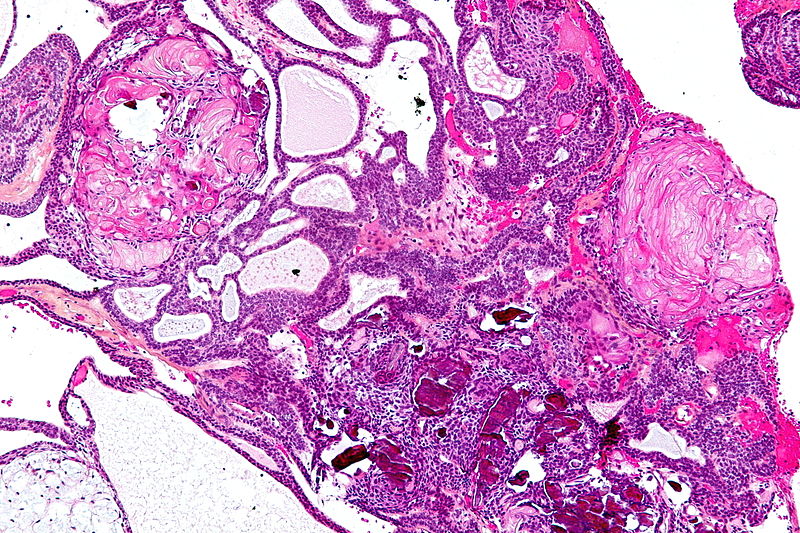Craniopharyngioma pathophysiology: Difference between revisions
No edit summary |
No edit summary |
||
| Line 7: | Line 7: | ||
They are very slow growing tumors. They arise from the cells along the [[pituitary stalk]]. They are classified as [[benign]].<ref name="pmid17630614">{{cite journal |author=Garrè ML, Cama A |title=Craniopharyngioma: modern concepts in pathogenesis and treatment |journal=Curr. Opin. Pediatr. |volume=19 |issue=4 |pages=471-9 |year=2007 |pmid=17630614 |doi=10.1097/MOP.0b013e3282495a22}}</ref> | They are very slow growing tumors. They arise from the cells along the [[pituitary stalk]]. They are classified as [[benign]].<ref name="pmid17630614">{{cite journal |author=Garrè ML, Cama A |title=Craniopharyngioma: modern concepts in pathogenesis and treatment |journal=Curr. Opin. Pediatr. |volume=19 |issue=4 |pages=471-9 |year=2007 |pmid=17630614 |doi=10.1097/MOP.0b013e3282495a22}}</ref> | ||
Craniopharyngioma is a rare, usually [[suprasellar]]<ref name="pmid17592268">{{cite journal |author=Rodriguez FJ, Scheithauer BW, Tsunoda S, Kovacs K, Vidal S, Piepgras DG |title=The spectrum of malignancy in craniopharyngioma |journal=Am. J. Surg. Pathol. |volume=31 |issue=7 |pages=1020-8 |year=2007 |pmid=17592268 |doi=10.1097/PAS.0b013e31802d8a96}}</ref> neoplasm, which may be [[cystic]], that develops from the nests of epithelium derived from [[Rathke's pouch]]. | Craniopharyngioma is a rare, usually [[suprasellar]]<ref name="pmid17592268">{{cite journal |author=Rodriguez FJ, Scheithauer BW, Tsunoda S, Kovacs K, Vidal S, Piepgras DG |title=The spectrum of malignancy in craniopharyngioma |journal=Am. J. Surg. Pathol. |volume=31 |issue=7 |pages=1020-8 |year=2007 |pmid=17592268 |doi=10.1097/PAS.0b013e31802d8a96}}</ref> neoplasm, which may be [[cystic]], that develops from the nests of epithelium derived from [[Rathke's pouch]]. | ||
===Gross Pathology=== | |||
On macroscopic examination, craniopharyngiomas are cystic or partially cystic with solid areas. | |||
====Microscopic pathology==== | ====Microscopic pathology==== | ||
The [[histologic]] pattern consists of nesting of [[squamous]] [[epithelium]] bordered by radially arranged cells. It is frequently accompanied by calcium deposition and have a microscopic papillary architecture. Shown below is a micrograph showing the characteristic features of an adamantinomatous craniopharyngioma - cystic spaces, calcifications, and "wet" keratin. HPS stain. | The [[histologic]] pattern consists of nesting of [[squamous]] [[epithelium]] bordered by radially arranged cells. It is frequently accompanied by calcium deposition and have a microscopic papillary architecture. | ||
Two distinct types are recognized:<ref name="pmid12466115">{{cite journal |author=Sekine S, Shibata T, Kokubu A, ''et al'' |title=Craniopharyngiomas of adamantinomatous type harbor beta-catenin gene mutations |journal=Am. J. Pathol. |volume=161 |issue=6 |pages=1997–2001 |year=2002 |month=December |pmid=12466115 |pmc=1850925 |doi= |url=http://ajp.amjpathol.org/cgi/pmidlookup?view=long&pmid=12466115}}</ref><ref name="pmid15569047">{{cite journal |author=Sekine S, Takata T, Shibata T, ''et al'' |title=Expression of enamel proteins and LEF1 in adamantinomatous craniopharyngioma: evidence for its odontogenic epithelial differentiation |journal=Histopathology |volume=45 |issue=6 |pages=573–9 |year=2004 |month=December |pmid=15569047 |doi=10.1111/j.1365-2559.2004.02029.x |url=http://www3.interscience.wiley.com/resolve/openurl?genre=article&sid=nlm:pubmed&issn=0309-0167&date=2004&volume=45&issue=6&spage=573}}</ref> | |||
*Adamantinomatous craniopharyngioma and, | |||
*Papillary craniopharyngioma. | |||
In the adamantinomatous type, calcifications are visible on neuroimaging and are helpful in diagnosis. | |||
The papillary type rarely calcifies. | |||
On light microscopy, the cysts are seen to be lined by stratified squamous epithelium. Keratin pearls may also be seen. The cysts are usually filled with a yellow, viscous fluid which is rich in cholesterol crystals. In addition to a long list of possible symptoms, the most common presentation include: headaches, growth failure, and [[bitemporal hemianopsia]]. | |||
Shown below is a micrograph showing the characteristic features of an adamantinomatous craniopharyngioma - cystic spaces, calcifications, and "wet" keratin. HPS stain. | |||
Revision as of 18:10, 13 March 2013
|
Craniopharyngioma Microchapters |
|
Diagnosis |
|---|
|
Treatment |
|
Case Studies |
|
Craniopharyngioma pathophysiology On the Web |
|
American Roentgen Ray Society Images of Craniopharyngioma pathophysiology |
|
Risk calculators and risk factors for Craniopharyngioma pathophysiology |
Editor-In-Chief: C. Michael Gibson, M.S., M.D. [1]
Overview
Pathophysiology
They are very slow growing tumors. They arise from the cells along the pituitary stalk. They are classified as benign.[1]
Craniopharyngioma is a rare, usually suprasellar[2] neoplasm, which may be cystic, that develops from the nests of epithelium derived from Rathke's pouch.
Gross Pathology
On macroscopic examination, craniopharyngiomas are cystic or partially cystic with solid areas.
Microscopic pathology
The histologic pattern consists of nesting of squamous epithelium bordered by radially arranged cells. It is frequently accompanied by calcium deposition and have a microscopic papillary architecture. Two distinct types are recognized:[3][4]
- Adamantinomatous craniopharyngioma and,
- Papillary craniopharyngioma.
In the adamantinomatous type, calcifications are visible on neuroimaging and are helpful in diagnosis. The papillary type rarely calcifies. On light microscopy, the cysts are seen to be lined by stratified squamous epithelium. Keratin pearls may also be seen. The cysts are usually filled with a yellow, viscous fluid which is rich in cholesterol crystals. In addition to a long list of possible symptoms, the most common presentation include: headaches, growth failure, and bitemporal hemianopsia.
Shown below is a micrograph showing the characteristic features of an adamantinomatous craniopharyngioma - cystic spaces, calcifications, and "wet" keratin. HPS stain.
Shown below is a Micrograph showing a papillary craniopharyngioma. HPS stain.
References
- ↑ Garrè ML, Cama A (2007). "Craniopharyngioma: modern concepts in pathogenesis and treatment". Curr. Opin. Pediatr. 19 (4): 471–9. doi:10.1097/MOP.0b013e3282495a22. PMID 17630614.
- ↑ Rodriguez FJ, Scheithauer BW, Tsunoda S, Kovacs K, Vidal S, Piepgras DG (2007). "The spectrum of malignancy in craniopharyngioma". Am. J. Surg. Pathol. 31 (7): 1020–8. doi:10.1097/PAS.0b013e31802d8a96. PMID 17592268.
- ↑ Sekine S, Shibata T, Kokubu A; et al. (2002). "Craniopharyngiomas of adamantinomatous type harbor beta-catenin gene mutations". Am. J. Pathol. 161 (6): 1997–2001. PMC 1850925. PMID 12466115. Unknown parameter
|month=ignored (help) - ↑ Sekine S, Takata T, Shibata T; et al. (2004). "Expression of enamel proteins and LEF1 in adamantinomatous craniopharyngioma: evidence for its odontogenic epithelial differentiation". Histopathology. 45 (6): 573–9. doi:10.1111/j.1365-2559.2004.02029.x. PMID 15569047. Unknown parameter
|month=ignored (help)

